
95% of researchers rate our articles as excellent or good
Learn more about the work of our research integrity team to safeguard the quality of each article we publish.
Find out more
ORIGINAL RESEARCH article
Front. Sustain. Food Syst. , 18 October 2021
Sec. Climate-Smart Food Systems
Volume 5 - 2021 | https://doi.org/10.3389/fsufs.2021.741177
This article is part of the Research Topic Mixed Farming Technologies for Increased Resilience, Mitigation and Adaptation to a Changing Climate for Smallholder Farmers in Southern Africa View all 7 articles
Intercropping maize (Zea mays L.) with common bean (Phaseolus vulgaris L.) is one of the predominant farming practices in eastern and southern Africa (ESA) for effective use of resources and continuous household food supply. The productivity of sole or intercropped crops is subject to variety, location, year, and their interaction. Therefore, the objective of this study was to determine the productivity of newly released common bean varieties NUA45 and SER83 under sole cropping and intercropping with a maize hybrid variety SC672 as a guide to large-scale production. Experiments were conducted at Chitedze Agricultural Research Station (13.85°S; 33.38°E) and Linthipe Extension Planning Area (12.06°S; 33.25°E) in 2019 and 2020 in Malawi using a factorial arrangement laid out in a randomized complete block design (RCBD) with four replications. The numbers of pods per plant (NPP) and seeds per pod (NSP), grain yield (GYD), and 100-seed weight were collected for common bean included, while GYD was recorded for maize. The main effects for genotype, location, year, and intercropping system were significant (p < 0.05) for GYD in common bean. The effects of the year and cropping system and location by intercropping system interaction were significant for maize GYD. The maize yield did not vary between sole cropped and intercropped systems. The total land equivalent ratios (LERs) for NUA45 and SER83 were 1.59 and 1.77, respectively. The LER-values showed a significant difference (p < 0.034), suggesting a considerably higher benefit of maize and common bean intercropping. Overall, intercropping maize with common bean rendered higher yields in the SER83/SC672 intercropping system than the sole crop in the study areas. Therefore, intra-row intercropping of the newly released common bean variety SER83 with a maize hybrid variety SC672 is recommended in the study area and other similar agro-ecologies for stable and sustainable production of both crops.
Maize (Zea mays L.) and common bean (Phaseolus vulgaris L.) are important food and cash crops globally. Maize is the main staple crop in eastern and southern Africa (ESA) and accounts for 19% of the average calorie intake per person per day (Santpoort, 2020). Maize is also grown for livestock feed and as industrial raw material (Badu-Apraku and Fakorede, 2017). Common bean is a source of dietary calories and protein for more than 200 million people in ESA (Nkhata et al., 2021a). It is a vital commercial crop and a source of income in ESA, where 40% of the total annual production has been traded in the region. There is a burgeoning demand for common bean at local, regional, and international markets (Sichilima et al., 2016; Nkhata et al., 2021b). Common bean contributes to biological nitrogen fixation through a symbiotic association with Rhizobium leguminosarum biovar phaseoli. Hence, it is a valuable component in cereal-legume-based cropping systems to improve soil fertility and enhance yield gains of companion crops (Latati et al., 2016).
Maize and common bean are predominantly cultivated under low input and small-scale farming systems in ESA which are characterized by low yield gains (Nassary et al., 2020b). Annual total production of the two crops falls short of demand in ESA partly due to a shortage of agricultural lands, high human population pressure, urbanization, and an array of production constraints, including low soil fertility, drought, weeds, insect pests, and diseases (Sileshi et al., 2010; Singh, 2013; Jayne et al., 2014; Conceição et al., 2016; Badu-Apraku and Fakorede, 2017). For effective resource utilization and enhancing soil fertility and yield gains, intercropping of maize and common bean has long been recognized and practiced in ESA (Alemayehu et al., 2017; Nassary et al., 2020b).
Intercropping is the practice of growing two or more crops on the same land simultaneously (Machado, 2009). There are four main intercropping types: inter- or intra-row, strip, mixed, and relay intercropping. Intra-row intercropping used in the present study is the practice of growing two or more crops simultaneously on the same field within a row. The various advantages of the cropping system include suppressing weeds, insect pests, and disease (Fininsa, 2003); enhancing diversity and ecosystem functions; altering soil biota; and protecting and improving soil structure (Finn et al., 2013; Duchene et al., 2017).
In crop production systems, intercropping has been commonly practiced to maximize available resources and labor (Coll et al., 2012). It allows efficient use of resources such as soil moisture, solar radiation, and soil nutrients (Alemayehu et al., 2017; Nassary et al., 2020b). It also reduces insect pests and disease problems significantly when the intercropped species are affected by different causative agents (Theunissen and Schelling, 1996; Lopes et al., 2016). Intercropping permits higher and stable yields in many crop combinations with minimal production inputs such as fertilizers and crop protection chemicals. Intercropping has been an economical option of crop production systems in low input agricultural systems prevalent in ESA (Dyer et al., 2012; Abera et al., 2017). It is a viable strategy to minimize the risk of crop failure in unfavorable environmental conditions such as drought and heat stress.
Studies on bean intercropping with maize pinpointed the high grain yield (GYD) response and land-use efficiency compared with the corresponding monocultures (Worku, 2008; Nassary et al., 2020a,b). Nassary et al. (2020b) reported a two-fold GYD increase in the bean-maize intercropping system. The GYD increase in the reported studies could be attributable to the high crop growth rate; low incidences of insect pests, disease, and weeds; and practical resource use due to the difference in resource utilization and conversion among the companion crops (Alemayehu et al., 2017; Nassary et al., 2020b).
The productivity of monocropping or intercropping systems is dependent on crop variety, location, year, and their interaction. The benefits accrued from intercropping depend on the companion cultivars' compatibility in resource utilization such as nutrients, water, and light; tolerance to insect pests, diseases, and weed infestation; and various planting times, planting densities, and maturity periods. High yield advantage occurs when component crops have different growing periods, making their major demand of growth resources at different times (Seran and Brintha, 2010). Legume crops such as cowpea (Vigna unguiculata L.), groundnut (Arachis hypogaea L.), and common bean have been widely reported to be compatible with maize intercropping (Ghosh, 2004; Latati et al., 2014; Nassary et al., 2020b). However, compatibility varies among crop species and cultivars, necessitating detailed evaluation on agronomic performance and yield advantages before large-scale production is recommended (Worku, 2008; Abera et al., 2017).
The International Center for Tropical Agriculture (CIAT)/Malawi recently developed new common bean varieties denominated as “NUA45” and “SER83.” The two bean varieties are widely cultivated in southern African countries. NUA45 has medium maturity with mean days to maturity of 90 days, a large red mottled seed with bush growth habit, while SER83 is an early maturing (70 days) with a small red seed and bush growth form. NUA45 was released in Malawi (in 2009), the Democratic Republic of Congo (2012), Eswatini (2013), Lesotho (2011), Mauritius, Mozambique (2011), Zambia (2012), and Zimbabwe (2010); SER83 in 2018 in Malawi. NUA45 occupies 20% of the area allocated to bean production in Malawi. The total share of this variety compared to other bean varieties is 12 and 8% in Zimbabwe and Mozambique, respectively (Chirwa, personal communication). The average yield for NUA45 is 2,000 kg/ha in pure stand, experimental, or commercial production conditions, while SER83 recorded a yield of 2,500 kg/ha under the same conditions (CIAT, unpublished data). Most farmers in the region widely intercrop these varieties with maize (MOAFS, 2015; Silberg et al., 2017). However, their performance under intercropping systems has not been well-documented for large-scale recommendation and production. Therefore, the objective of this study was to determine the productivity of the newly released common bean varieties NUA45 and SER83 under sole cropping and intercropping with a maize hybrid variety SC672 to guide large-scale production.
The study used two common bean varieties NUA45 and SER83 developed by the International Center for Tropical Agriculture (CIAT)/Malawi. In Malawi, the varieties were released by the Department of Agricultural Research Services (DARS). Also, the study used a three-way hybrid maize variety SC672 developed by SeedCo/Zimbabwe and recently registered in Malawi. The variety NUA45 has a large red-mottle seed and bred for high iron and zinc contents to reduce malnutrition (Hoppler et al., 2014), while SER83 has a small red seed and bred for high yield and drought tolerance (Mazengo et al., 2019). The maize hybrid SC672 is a medium maturing white grain genotype.
Field experiments were conducted at Chitedze Agricultural Research Station located 30 km east of Lilongwe (13.85°S; 33.38°E) and Linthipe in Dedza district (12.06°S; 33.25°E) during the 2019 and 2020 growing seasons. During the experiments, the total rainfall received was 638.10 and 736.60 mm for the Chitedze site in the 2018/2019 and 2019/2020 cropping seasons, respectively (Table 1). Total rainfall of 695 mm was recorded at the Linthipe site in the 2018/2019 cropping season, of which the bean crop received 89%. In the 2019/2020 cropping season, total rainfall of 760.50 mm was recorded at the Linthipe site, of which the bean crop received 90% during December to March. The two sites received more rains in 2019/2020 compared to the 2018/2019 cropping season.
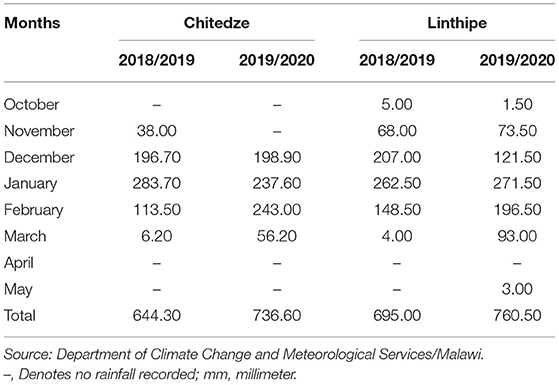
Table 1. Mean monthly rainfall (mm) at Chitedze and Linthipe in 2018/2019 and 2019/2020 cropping seasons.
Soil sample collection was conducted before land preparation in both sites. Preliminary soil analysis revealed that Chitedze has sandy loam soil while Linthipe has sandy clay loam soil (Table 2). The soils at the Chitedze and Linthipe sites had pH-values of 6.12 and 6.16, respectively. According to Chilimba (2007), the primary soil nutrients for plant growth, including nitrogen and phosphorus, were adequate for common bean and maize production at the Chitedze and Linthipe sites. The soils of both sites have adequate soil nutrients for common bean production. However, the loamy clay soils at the Linthipe site should possibly provide good water retention. In addition, the soil at the Linthipe site was rich in organic matter, organic carbon, and nitrogen compared to the Chitedze site.
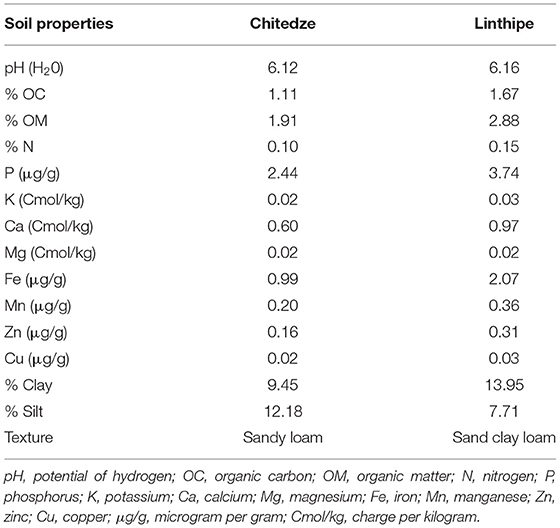
Table 2. Mean soil physical and chemical properties sampled from the 0–20-cm depth at Chitedze and Linthipe experimental sites in 2018/2019 and 2019/2020 cropping seasons.
The experiments were conducted in two seasons (2018/2019 and 2019/2020) at Chitedze and Linthipe sites. Two cropping systems were followed, namely, sole cropping and intra-row intercropping (Figure 1). Factorial experiments were conducted at each site using a randomized complete block design (RCBD) with four replications. The factors included two cropping systems (sole cropping and intra-row intercropping), two common bean varieties (NUA45 and SER83), a three-way hybrid maize variety SC672, two locations (Chitedze and Linthipe), and 2 years (2018/2019 and 2019/2020) (Table 3).
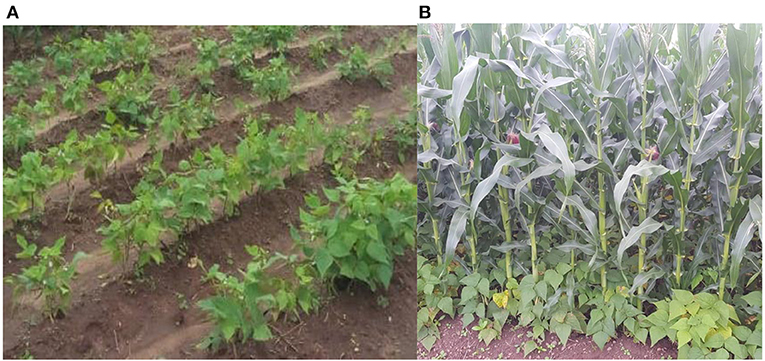
Figure 1. Cropping systems used in the study. (A) Sole bean crop variety NUA45, (B) intra-row intercrop of a maize variety SC627 and common bean variety SER 83 at the Chitedze site in the 2018/2019 cropping season.
The experiments were established on fields previously planted with maize. The experimental units consisted of plots measured at 3 × 4 m with a path of 1 m between blocks/replicates and 75 cm between plots. Maize or common bean seed were sown in each planting hole. The maize variety SC672 was sown at a spacing of 75 cm between rows and 25 cm within a row. Consequently, there were four rows in a plot, 16 plants in a row, and 64 plants in a plot, equivalent to 53,333 maize plants per ha. Common bean was sown at a spacing of 75 cm between rows and 10 cm in a row, making a total of 40 plants per row and 160 per plot equivalent to 133,333 bean plants per ha in a pure stand condition (Figure 1). The population of both crops was the same in either intercrop or sole due to optimized land. Compound inorganic fertilizers (23% N, 10% P, and 15% K) at a rate of 23 kg/ha of nitrogen, 15 kg/ha of phosphorus, and 10 kg/ha of potassium were applied during sowing. Urea (46% N) at a rate of 46 kg/ha was applied around each maize plant 21 days after sowing. The rates of fertilizer application are based on blanket recommendations in Malawi for common bean and maize. Weeding was conducted manually using hand hoes as often as necessary. Other cultural practices were followed as recommended for both crops.
The following agronomic traits were recorded for common bean: the number of pods per plant (NPP) recorded as the average number of pods counted on five randomly selected and tagged plants per plot at harvest; the number of seeds per pod (NSP) was recorded as the total number of seeds divided by the number of pods from five randomly selected plants in a plot at harvest; GYD for common bean was measured as the weight of shelled grain harvested from all plants in a plot and converted to kilogram per hectare after adjusting for 12% moisture content (Equation 1). Grain yield data were recorded for maize given that the emphasis was on common bean yield components. Grain yield for maize was measured as weight of grain harvested from all plants in a plot and converted to kilogram per hectare after adjusting for 12% moisture content (Equation 1).
Grain yield (GYD) is the grain yield per hectare in kilogram, and MC is the percentage moisture of the grain at harvest. Hundred seed weight (HSW) was recorded as the weight of 100 randomly selected seeds after adjusting to 12% moisture content.
Data on agronomic traits were subjected to combined analysis of variance (ANOVA) in Genstat 18th edition (Payne et al., 2017) after testing for homogeneity variance across sites and years. Variety, cropping system, location, and year effects were treated as fixed effects, whereas replicates/blocks were treated as random effects. A post-hoc Turkey's HSD test at a threshold of 5% was used to compare treatment means.
The efficiency of intercropping compared to sole cropping was assessed using the LER (Willey, 1979). The LER indicates crop performance and resource use efficiency in intercropping over sole cropping (Agegnehu et al., 2008). The LER is calculated as the sum of the intercrop yield ratio and the sole yield for each crop species (Equation 2). The ratio (Equations 3 and 4) of intercrop and sole crop yields of the individual crop is called the partial land equivalent ratio (PLER) (Dhima et al., 2007; Worku, 2008; Nassary et al., 2020a). The LER > 1 indicates that intercropping is advantageous in yield gains and land-use efficiency. The significant effects of the LER-values were inferred using the independent t-test procedure with the SPSS version 16 (SPSS, 2006).
The combined ANOVA (Table 4) revealed the presence of highly significant location × year × cropping system interaction effects (p < 0.01) for NPP. Genotype × cropping system interaction effect was significant (p < 0.05) for NPP, while location × cropping system interaction effect was significant (p < 0.05) for HSW. Location effects were highly significant (p < 0.001) for GYD. Cropping system effects were highly significant (p < 0.001) for NPP and GYD. Genotypic effects were significant (p < 0.001) for NPP, NSP, GYD, and HSW. The ANOVA (Table 4) revealed the presence of significant cropping system × location effects (p < 0.05) for GYD of maize intercropped with common bean genotypes. Significant effects (p < 0.05) for GYD of maize were recorded for the cropping system.
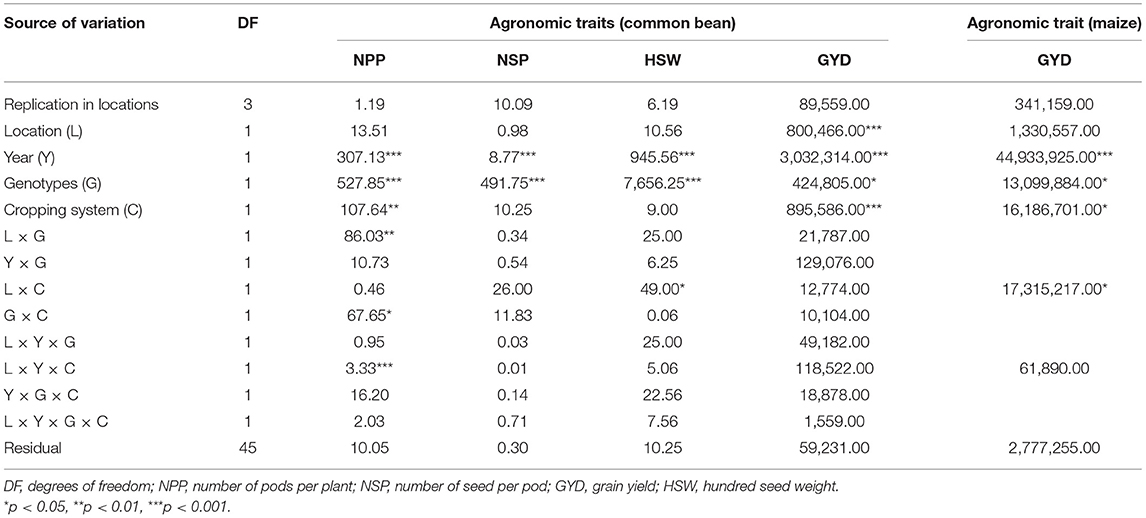
Table 4. Combined analysis of variance with mean squares and a significant test for agronomic traits of two common bean genotypes when cultivated as a sole crop or intercropped with a maize variety at Chitedze and Linthipe in 2018/2019 and 2019/2020 cropping season.
At Chitedze, the mean NPP was 12, while at Linthipe, it was 13 (Table 5). The NPP was higher in the 2019/2020 season than in the 2018/2019 season. SER83 had higher NPP (16) compared to NUA45 (10). The average for NPP across season and site was higher in sole cropping system (14) than intercrop (12). SER83 in sole cropping had the highest NPP (18), followed by SER83 in intercrop (13). NUA45 had an NPP of 10 under both sole and intercropping. The recorded NSP mean was 5, with SER83 having a higher NSP (6) than NUA45 (4). NUA45 had a higher HSW, and it ranged from 43.75 to 53.75 g compared to SER83, which ranged from 20.00 to 30.25 g. The recorded mean GYD in 2019/2020 was 1002 kg/ha, while in 2018/2019 it was 566 kg/ha (Table 5). Overall, SER83 recorded a higher GYD of than NUA45 (Figure 2). SER83 in sole crop recorded the highest GYD followed by NUA45 in sole crop and SER83 in intercrop. Overall, GYD was higher in sole crop than in intercrop (Figure 2). The GYD for bean was higher in 2019/2020 than in the 2018/2019 growing season at both locations, and between locations, higher GYD was recorded at Linthipe than Chitedze (Figure 3). A summary of GYD for maize intercropped with the bean is presented in Table 6. Maize in a sole crop recorded a higher GYD across testing sites and seasons than maize intercropped with the common bean. The mean GYD at Chitedze was higher in 2019/2020 (8,313 kg/ha) compared to the 2018/2019 growing season (6,903.60). The mean GYD at Linthipe was 8,282.10 kg/ha in 2019/2020 and 5,486.40 kg/ha in the 2018/2019 growing season. Maize intercropped with SER83 recorded GYD slightly higher than in a sole crop. Maize intercropped with NUA45 recorded the lowest GYD in the study (Figure 4).

Table 5. Means for agronomic traits of common bean genotypes from a maize–common bean intercropping at Chitedze and Linthipe in 2018/2019 and 2019/2020 growing season.
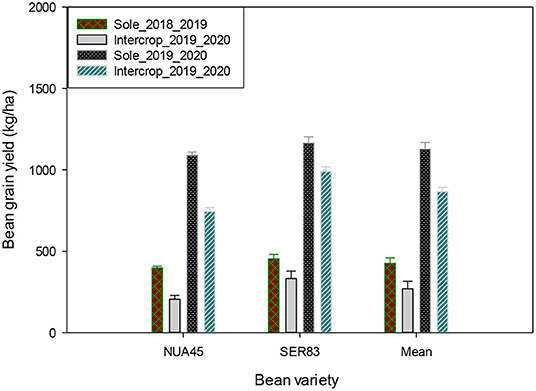
Figure 2. Grain yield (kg/ha) between two newly released common bean varieties NUA45 and SER83 under sole and intercropping systems with a maize variety SC672 evaluated at Chitedze and Linthipe during the 2018/2019 and 2019/2020 growing seasons.
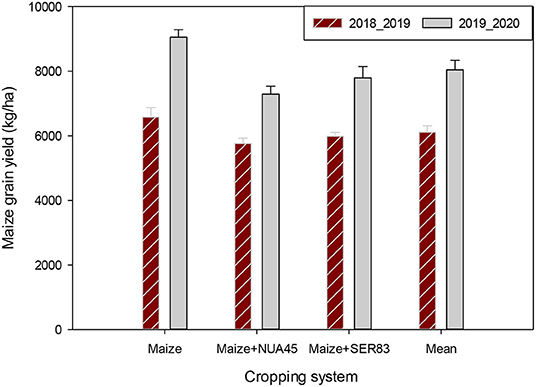
Figure 3. Grain yield (kg/ha) of common bean under sole and intercropping systems with a maize variety SC672 evaluated at Chitedze and Linthipe during 2018/2019 and 2019/2020 growing seasons.
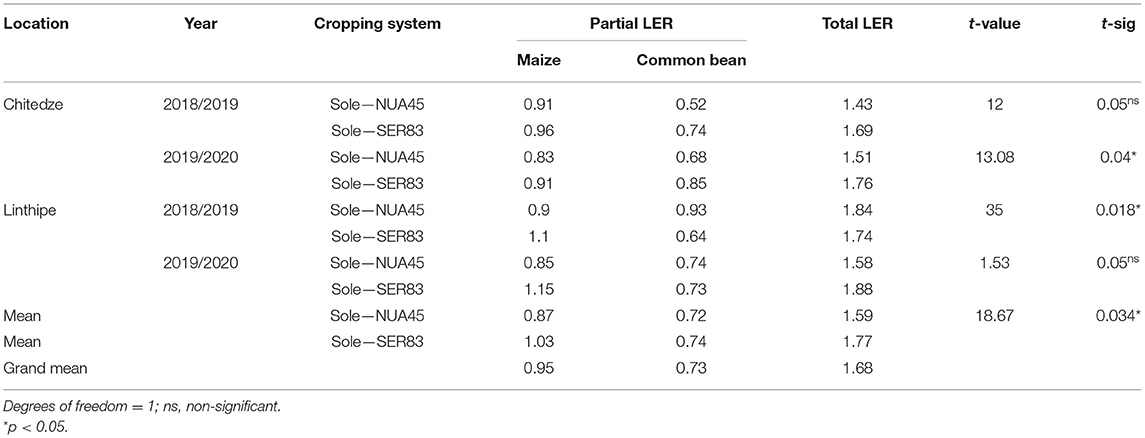
Table 6. Means of partial land equivalent ratio (PLER) and total LER from intercropping a maize variety with two common bean varieties NUA45 and SER83 at Chitedze and Linthipe in 2019 and 2020.
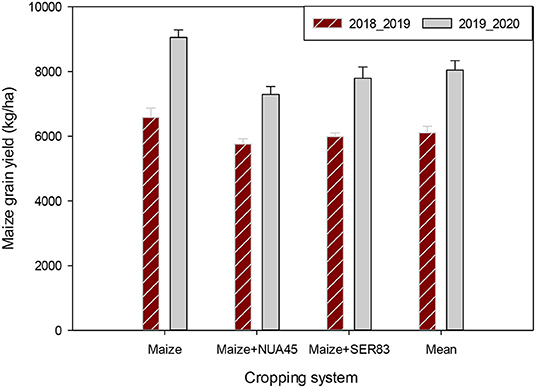
Figure 4. Grain yield (kg/ha) of maize variety under sole and intercropping systems with newly released common bean varieties NUA45 and SER83 evaluated at Chitedze and Linthipe during 2018/2019 and 2019/2020 growing seasons.
The partial LER for the maize component (Table 7) varied with bean genotype, growing season, and location. The mean partial LER of maize intercropped with NUA45 was 0.87, while SER83 recorded a partial LER of 1.03. The mean total LER was more significant than 1 in both common bean varieties, indicating that intercropping is advantageous than sole cropping in the present study. The LER-values of NUA45 and SER83 were 1.59 and 1.77, respectively, showing a significant difference (p < 0.034). Results indicate a 159% yield advantage for NUA45 if grown in association with maize and 177% if SER83 is grown with maize.
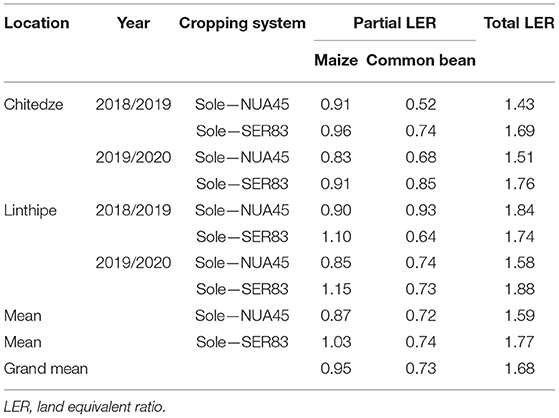
Table 7. Simple t-test of total land equivalent ratio (LER) from intercropping a maize variety with two common bean varieties NUA45 and SER83 at Chitedze and Linthipe in 2019 and 2020.
The significant interaction effects of location, year, genotype, and cropping system for the evaluated common bean agronomic traits (Table 4) suggest that environment, genotype, and cropping system effects determined the performance of the tested common bean varieties. Common bean-maize intercropping studies (Santalla et al., 2001; Worku, 2008; Nassary et al., 2020b) showed interactive effects among the component crops. The significant location × year × cropping interaction effects on NPP indicate that the test location and year (environment) influence GYD production in a bean–maize intercrop. This interaction would complicate selection due to crossover ranking in different environments. This finding corroborates earlier reports that suggested that cropping season, location, and cropping system greatly influence the overall performance of the common bean (Santalla et al., 1999; Worku, 2008; Nassary et al., 2020b). Multiple seasons and locations testing trials are necessary before selecting the variety and cropping systems for recommendation to farmers. Grain yield and other agronomic traits varied significantly between the test genotypes. The evaluated bean genotypes are divergent and belong to distinct gene pools; SER83 is a Mesoamerican bean genotype, while NUA45 is an Andean genotype (Nkhata et al., 2020). Mesoamericans have a significantly small seed size when compared with Andean (Santalla et al., 2005). Mesoamerican has a higher yield potential than the Andean beans (Polania et al., 2016).
The significant impact of location by cropping system for GYD of maize may be attributable to different soil properties (Table 4). Linthipe has loamy clay soils, possibly with good water retention. In addition, Linthipe soils were rich in organic matter, organic carbon, and nitrogen compared to Chitedze. These mineral elements are essential for maize growth and productivity. The significant location × cropping interaction on maize yield implies that a particular cropping system could be site-specific. Atuahene-Amankwa et al. (2004) reported a significant location × cropping system interaction in a similar study. Significant effects exerted by the cropping system on maize yield performance suggest that maize performed differently between the two cropping systems. The attributing factor could be interspecific competition for growth resources of maize grown in association with common bean, which was absent in maize grown in the pure stand (Cardoso et al., 2007; Nassary et al., 2020a).
Grain yield and other agronomic traits varied between the cropping systems (Table 5; Figures 2, 3). Common bean intercropped with maize recorded a lower yield than the sole bean. The results corroborate previous maize–bean intercrop studies (Worku, 2008; Yilmaz et al., 2008). The factors contributing to lower bean GYD could be stiff interspecific competition belowground and aboveground for growth resources between the two species in the intercrop (Nassary et al., 2020a). Common bean has a short root system compared to maize. This likely reduced the competitive advantage for essential growth factors such as water, nutrients, and mineral salts.
Similarly, above-the-ground competition for air, water, and light favored maize. Additionally, maize has a height advantage over common bean, reducing adequate light for the bean plant to optimal photosynthesis. The arguments are similar to the findings in previous studies (Brooker et al., 2015; Nassary et al., 2020b). Maingi et al. (2001) reported that C4 species outcompete C3 plants, and the yield of C3 is suppressed in intercropping systems. Both varieties suffered approximately the same yield loss in the intercrop system compared to yield in pure stand. The yield response suggests that the genotypes have the same competitive ability when planted in association with maize. On the contrary, common bean genotypes suffered a further yield loss in a similar study (Atuahene-Amankwa et al., 2004).
Grain yield of maize, when cultivated in association with SER83, was higher than that of maize in a pure stand (Table 8; Figure 4). The results are in line with previous findings in maize–bean intercrop (Alemayehu et al., 2017) and maize–soybean intercrop (Amini et al., 2013). Nitrogen from inorganic fertilizers plus nitrogen fixed by common bean increase total GYD of maize in the intercrop compared with sole crop due to the efficient utilization of growth resources. Nitrogen fixed by common bean supplemented the inorganic nitrogen-added enhanced maize production (Brooker et al., 2015; Kermah et al., 2017). SER83 is drought tolerant with high water use efficiency, which has likely reduced competition for water between the maize and SER83 bean variety (Nassary et al., 2020a). Conversely, GYD of maize is low under maize–NUA45 intercrop. NUA45 is a late-maturing variety compared to SER83 which probably formed nodules during vegetative growth used by the maize crop.
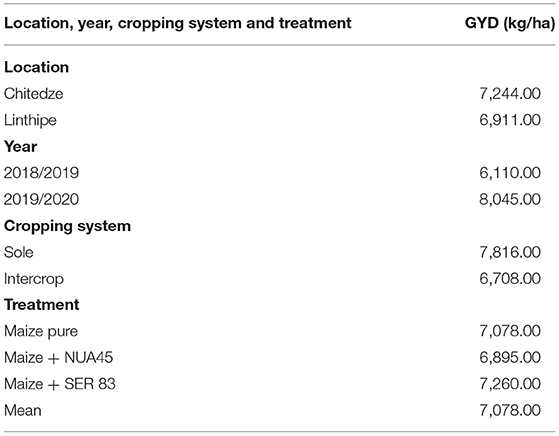
Table 8. Means of location, year, cropping system, treatment, and contrast for grain yield of maize from a maize common bean intercropping at Chitedze and Linthipe in 2019 and 2020.
The total LERs of 1.59 and 1.77 for NUA45 and SER83 (Table 6) indicate that intercropping enhanced the productivity of the common bean varieties NUA45 and SER83 compared to sole cropping. In an intercrop system, if LER is >1, the intercropping has advantages over sole cropping. Similarly, higher LER-values of 1.60, 1.85, and 2.47 were reported by Santalla et al. (2001), Latati et al. (2016), and Nassary et al. (2020b), respectively, in maize–bean intercrop studies. Total LERs greater than the unit value in maize–bean intercrop have been reported widely in similar studies (Worku, 2008; Abera et al., 2017; Nassary et al., 2020a). Overall, in the study, intercropping maize with common bean rendered higher yield outputs in the SER83/SC672 intercropping system than the sole crop in the study areas. Therefore, intra-row intercropping of the newly released common bean variety SER83 with a maize hybrid variety SC672 is recommended in the study area and other similar agro-ecologies for stable and sustainable production of both crops.
The maize yield did not vary between sole cropped and intercropped systems. The total LERs for NUA45 and SER83 were 1.59 and 1.77, respectively, suggesting considerably higher benefits from maize and common bean intercropping. Overall, intercropping maize with common bean showed a considerable yield advantage in the SER83/SC672 intercropping system than the sole crop in the study areas. Therefore, intra-row intercropping of the newly released common bean variety SER83 with a maize hybrid variety SC672 is recommended in the study area and other similar agro-ecologies for sustainable production of both crops. Further research on the two cropping systems' social and economic benefit analysis would be of paramount importance.
The raw data supporting the conclusions of this article will be made available by the authors, without undue reservation.
WN, HS, and RC contributed to the writing of this article. HS and RC contributed to the editing and reviewing of the article. WN contributed to the original draft and data analysis. All authors contributed to the article and approved the submitted version.
This research publication was made possible with support from the United States Agency for International Development (USAID) through the Africa Research in Sustainable Intensification for the Next Generation (Africa RISING) program as part of the US Government's Feed the Future Initiative. The authors also acknowledge various contributions by the Alliance of Bioversity and CIAT.
The authors declare that the research was conducted in the absence of any commercial or financial relationships that could be construed as a potential conflict of interest.
All claims expressed in this article are solely those of the authors and do not necessarily represent those of their affiliated organizations, or those of the publisher, the editors and the reviewers. Any product that may be evaluated in this article, or claim that may be made by its manufacturer, is not guaranteed or endorsed by the publisher.
The authors thank the USAID Feed the Future Program and the Alliance for Bioversity, and the International Center for Tropical Agriculture (ABC) for the financial support and provision of germplasm used in the study.
Abera, R., Worku, W., and Beyene, S. (2017). Performance variation among improved common bean (Phaseolus vulgaris L.) genotypes under sole and intercropping with maize (Zea mays L.). Afri J. Agric. Res 12, 397–405. doi: 10.5897/AJAR2016.11794
Agegnehu, G., Ghizaw, A., and Sinebo, W. (2008). Yield potential and land-use efficiency of wheat and faba bean mixed intercropping. Agron. Sus. Dev. 28, 257–263. doi: 10.1051/agro:2008012
Alemayehu, A., Tamado, T., Nigussie, D., Yigzaw, D., Kinde, T., and Wortmann, C. S. (2017). Maize–common bean intercropping to optimize maize-based crop production. J. Agric. Sci. 155, 1–13. doi: 10.1017/S0021859617000193
Amini, R., Shamayeli, M., and Dabbagh Mohammadi Nasab, A. (2013). Assessment of yield and yield components of corn (Zea mays L.) under two and three strip intercropping systems. Int. J. Biosci. 3, 65–69. doi: 10.12692/ijb/3.3.65-69
Atuahene-Amankwa, G., Beatie, A., Michaels, T. E., and Falk, D. (2004). Cropping system evaluation and selection of common bean genotypes for a maize/bean intercrop. Afri. Crop Sci. J. 12, 105–113. doi: 10.4314/acsj.v12i2.27668
Badu-Apraku, B., and Fakorede, M. (2017). “Maize in Sub-Saharan Africa: importance and production constraints,” in Advances in Genetic Enhancement of Early and Extra-Early Maize for Sub-Saharan Africa, eds B. Badu-Apraku and M. Fakorede (Cham: Springer), 3–10. doi: 10.1007/978-3-319-64852-1_20
Brooker, R. W., Bennett, A. E., Cong, W. F., Daniell, T. J., George, T. S., Hallett, P. D., et al. (2015). Improving intercropping: a synthesis of research in agronomy, plant physiology and ecology. New Phytol. 206, 107–117. doi: 10.1111/nph.13132
Cardoso, E., Nogueira, M., and Ferraz, S. (2007). Biological N2 fixation and mineral N in common bean-maize intercropping or sole cropping in south-eastern Brazil. Exp. Agric. 43, 319–330. doi: 10.1017/S0014479707005029
Chilimba, A. (2007). Methods of Soils, Plants, Fertilizers and Misclaneous Analyses: A Working Manual for Chitedze and Bvumbwe Research Stations Soils Laboratories. Ministry of Agriculture. Lilongwe, Malawi.
Coll, L., Cerrudo, A., Rizzalli, R., Monzon, J. P., and Andrade, F. H. (2012). Capture and use of water and radiation in summer intercrops in the south-east Pampas of Argentina. Field Crops Res. 134, 105–113. doi: 10.1016/j.fcr.2012.05.005
Conceição, P., Levine, S., Lipton, M., and Warren-Rodrígue, A. (2016). Toward a food secure future: ensuring food security for sustainable human development in Sub-Saharan Africa. Food Pol. 60, 1–9. doi: 10.1016/j.foodpol.2016.02.003
Dhima, K., Lithourgidis, A. I., Vasilakoglou, I., and Dordas, C. (2007). Competition indices of common vetch and cereal intercrops in two seeding ratio. Field Crops Res. 100, 249–256. doi: 10.1016/j.fcr.2006.07.008
Duchene, O., Vian, J. F., and Celette, F. (2017). Intercropping with legume for agroecological cropping systems: complementarity and facilitation processes and the importance of soil microorganisms. A review. Agric. Ecosysst. Environ. 240, 148–161. doi: 10.1016/j.agee.2017.02.019
Dyer, L., Oelbermann, M., and Echarte, L. (2012). Soil carbon dioxide and nitrous oxide emissions during the growing season from temperate maize-soybean intercrops. J. Plant Nutri. Soil Sci. 175, 394–400. doi: 10.1002/jpln.201100167
Fininsa, C. (2003). Relationship between common bacterial blight severity and bean yield loss in pure stand and bean maize intercropping systems. Inter. J. Pest Manage. 49, 177–185. doi: 10.1080/0967087021000049269
Finn, J. A., Kirwan, L., Connolly, J., Sebastià, M. T., Helgadottir, A., Baadshaug, O. H., et al. (2013). Ecosystem function enhanced by combining four functional types of plant species in intensively managed grassland mixtures: a 3-year continental-scale field experiment. J. Appl. Ecol. 50, 365–375. doi: 10.1111/1365-2664.12041
Ghosh, P. (2004). Growth, yield, competition and economics of groundnut/cereal fodder intercropping systems in the semi-arid tropics of India. Field Crops Res. 88, 227–237. doi: 10.1016/j.fcr.2004.01.015
Hoppler, M., Egli, I., Petry, N., Gille, D., Zeder, C., Walczyk, T., et al. (2014). Iron speciation in beans (Phaseolus vulgaris L) biofortified by common breeding. J. Food Sci. 79:1629–1634. doi: 10.1111/1750-3841.12548
Jayne, T. S., Chamberlin, J., and Headey, D. D. (2014). Land pressures, the evolution of farming systems, and development strategies in Africa: a synthesis. Food Pol. 48, 1–17. doi: 10.1016/j.foodpol.2014.05.014
Kermah, M., Franke, A. C., Adjei-Nsiah, S., Ahiabor, B. D., Abaidoo, R. C., and Giller, K. E. (2017). Maize-grain legume intercropping for enhanced resource use efficiency and crop productivity in the Guinea savanna of northern Ghana. Field Crops Res. 213, 38–50. doi: 10.1016/j.fcr.2017.07.008
Latati, M., Bargaz, A., Belarbi, B., Lazali, M., Benlahrech, S., Tellah, S., et al. (2016). The intercropping common bean with maize improves the rhizobial efficiency, resource use and grain yield under low phosphorus availability. Eur. J. Agron. 72, 80–90. doi: 10.1016/j.eja.2015.09.015
Latati, M., Blavet, D., Alkama, N., Laoufi, H., Drevon, J. J., Gerard, F., et al. (2014). The intercropping cowpea-maize improves soil phosphorus availability and maize yields in an alkaline soil. Plant Soil. 385, 181–191. doi: 10.1007/s11104-014-2214-6
Lopes, T., Hatt, S., Xu, Q., Chen, J., Liu, Y., and Francis, F. (2016). Wheat (Triticum aestivum L.)-based intercropping systems for biological pest control. Pest Manage. Sci. 72, 2193–2202. doi: 10.1002/ps.4332
Machado, S. (2009). Does intercropping have a role in modern agriculture? J. Soil Water Conserv. 64, 55–57. doi: 10.2489/jswc.64.2.55A
Maingi, J. M., Shisanya, C. A., Gitonga, N. M., and Hornetz, B. (2001). Nitrogen fixation by common bean (Phaseolus vulgaris L.) in pure and mixed stands in semi-arid south-east Kenya. Eur. J. Agron. 14, 1–12. doi: 10.1016/S1161-0301(00)00080-0
Mazengo, K. D., Tryphone, G. M., and Tarimo, A. J. (2019). Identification of drought selection indices of common bean (Phaseolus vulgaris L.) genotypes in the Southern Highlands of Tanzania. Afri. J. Agric. Res. 14, 161–167. doi: 10.5897/AJAR2018.13370
Nassary, E. K. F., Baijukya, F., and Ndakidemi, P.A. (2020a). Assessing the productivity of common bean in intercrop with maize across agro-ecological zones of smallholder farms in the Northern Highlands of Tanzania. Agriculture 10, 117–132. doi: 10.3390/agriculture10040117
Nassary, E. K. F., Baijukya, F., and Ndakidemi, P.A. (2020b). Productivity of intercropping with maize and common bean over five cropping seasons on smallholder farms of Tanzania. Eur. J. Agron. 113, 125964. doi: 10.1016/j.eja.2019.125964
Nkhata, W., Shimelis, H., Melis, R., Chirwa, R., Mathew, I., Shayanowako, A., et al. (2021a). Assessment of smallholder farmers' awareness of bean fly (Ophiomyia spp.) and management practices in central and northern Malawi: implications for resistance breeding. Crop Protect. 139, 105353. doi: 10.1016/j.cropro.2020.105353
Nkhata, W., Shimelis, H., Melis, R., Chirwa, R., Mzengeza, T., Mathew, I., et al. (2020). Population structure and genetic diversity analyses of common bean germplasm collections of East and Southern Africa using morphological traits and high-density SNP markers. PLoS ONE 15, e0243238. doi: 10.1371/journal.pone.0243238
Nkhata, W., Shimelis, H., Melis, R., Chirwa, R., Mzengeza, T., Mathew, I., et al. (2021b). Selection for bean fly (Ophiomyia spp) resistance and agronomic performance in selected common bean (Phaseolus vulgaris L.) accessions. Crop Protect. 140:105404. doi: 10.1016/j.cropro.2020.105404
Payne, R., Murray, D., and Harding, S. (2017). An Introduction to GenStat Command Language, 18th Edn. Hampstead: VSN Inter.
Polania, J., Rao, I. M., Cajiao, C., Rivera, M., Raatz, B., and Beebe, S. (2016). Physiological traits associated with drought resistance in Andean and Mesoamerican genotypes of common bean (Phaseolus vulgaris L.). Euphytica 210, 17–29. doi: 10.1007/s10681-016-1691-5
Santalla, M., Casquero, P., and De Ron, A. (1999). Yield and yield components from intercropping improved bush bean cultivars with maize. J. Agron. Crop Sci. 183, 263–269. doi: 10.1046/j.1439-037x.1999.00348.x
Santalla, M., Lema, M., Rodino, A., González, A., Monteagudo, A., and De Ron, A. (2005). Improvement of large-seeded common bean cultivars under sustainable cropping systems in Spain. Euphytica 142, 85–95. doi: 10.1007/s10681-005-0816-z
Santalla, M., Rodino, A., Casquero, P., and De Ron, A. (2001). Interactions of bush bean intercropped with field and sweet maize. Eur. J. Agron. 15, 185–196. doi: 10.1016/S1161-0301(01)00104-6
Santpoort, R. (2020). The drivers of maize area expansion in Sub-Saharan Africa. How policies to boost maize production overlook the interests of smallholder farmers. Land 9, 68–81. doi: 10.3390/land9030068
Seran, T. H., and Brintha, I. (2010). Review on maize based intercropping. J. Agron. 9, 135–145. doi: 10.3923/ja.2010.135.145
Sichilima, T., Mapemba, L., and Tembo, G. (2016). Drivers of dry common beans trade in Lusaka, Zambia: a trader's perspective. Sustain. Agric. Res. 5, 15–26. doi: 10.5539/sar.v5n2p15
Silberg, T. R., Richardson, R. B., Hockett, M., and Snapp, S. S. (2017). Maize-legume intercropping in central Malawi: determinants of practice. Int. J. Agric. Sustain. 15, 662–680. doi: 10.1080/14735903.2017.1375070
Sileshi, G., Akinnifesi, F. K., Debusho, L. K., Beedy, T., Ajayi, O. C. S., et al. (2010). Variation in maize yield gaps with plant nutrient inputs, soil type and climate across sub-Saharan Africa. Field Crops Res. 116, 1–13. doi: 10.1016/j.fcr.2009.11.014
Singh, S. P. (2013). “Production and utilisation,” Common Bean Improvement in the Twenty-First Century, ed S. P. Singh (London: Kluwer Academic Publishers), 18–21.
Theunissen, J., and Schelling, G. (1996). Pest and disease management by intercropping: suppression of thrips and rust in leek. Int. J. Pest Manage. 42, 227–234. doi: 10.1080/09670879609372000
Willey, R. (1979). Intercropping-its importance and research needs. Part 2, agronomy research approaches. Field Crops Abstr. 32, 73–85.
Worku, W. (2008). Evaluation of common bean (Phaseolus vulgaris L.) genotypes of diverse growth habit under sole and intercropping with maize (Zea mays L.) in southern Ethiopia. J. Agron. 7, 306–313. doi: 10.3923/ja.2008.306.313
Keywords: grain yield, intercropping system, land equivalent ratio, maize, sole crop
Citation: Nkhata W, Shimelis H and Chirwa R (2021) Productivity of Newly Released Common Bean (Phaseolus vulgaris L.) Varieties Under Sole Cropping and Intercropping With Maize (Zea mays L.). Front. Sustain. Food Syst. 5:741177. doi: 10.3389/fsufs.2021.741177
Received: 14 July 2021; Accepted: 14 September 2021;
Published: 18 October 2021.
Edited by:
Adornis Dakarai Nciizah, Agricultural Research Council, South AfricaReviewed by:
Ernest Dube, Nelson Mandela University, South AfricaCopyright © 2021 Nkhata, Shimelis and Chirwa. This is an open-access article distributed under the terms of the Creative Commons Attribution License (CC BY). The use, distribution or reproduction in other forums is permitted, provided the original author(s) and the copyright owner(s) are credited and that the original publication in this journal is cited, in accordance with accepted academic practice. No use, distribution or reproduction is permitted which does not comply with these terms.
*Correspondence: Wilson Nkhata, d2lsc29ua2hhdGFAZ21haWwuY29t
Disclaimer: All claims expressed in this article are solely those of the authors and do not necessarily represent those of their affiliated organizations, or those of the publisher, the editors and the reviewers. Any product that may be evaluated in this article or claim that may be made by its manufacturer is not guaranteed or endorsed by the publisher.
Research integrity at Frontiers

Learn more about the work of our research integrity team to safeguard the quality of each article we publish.